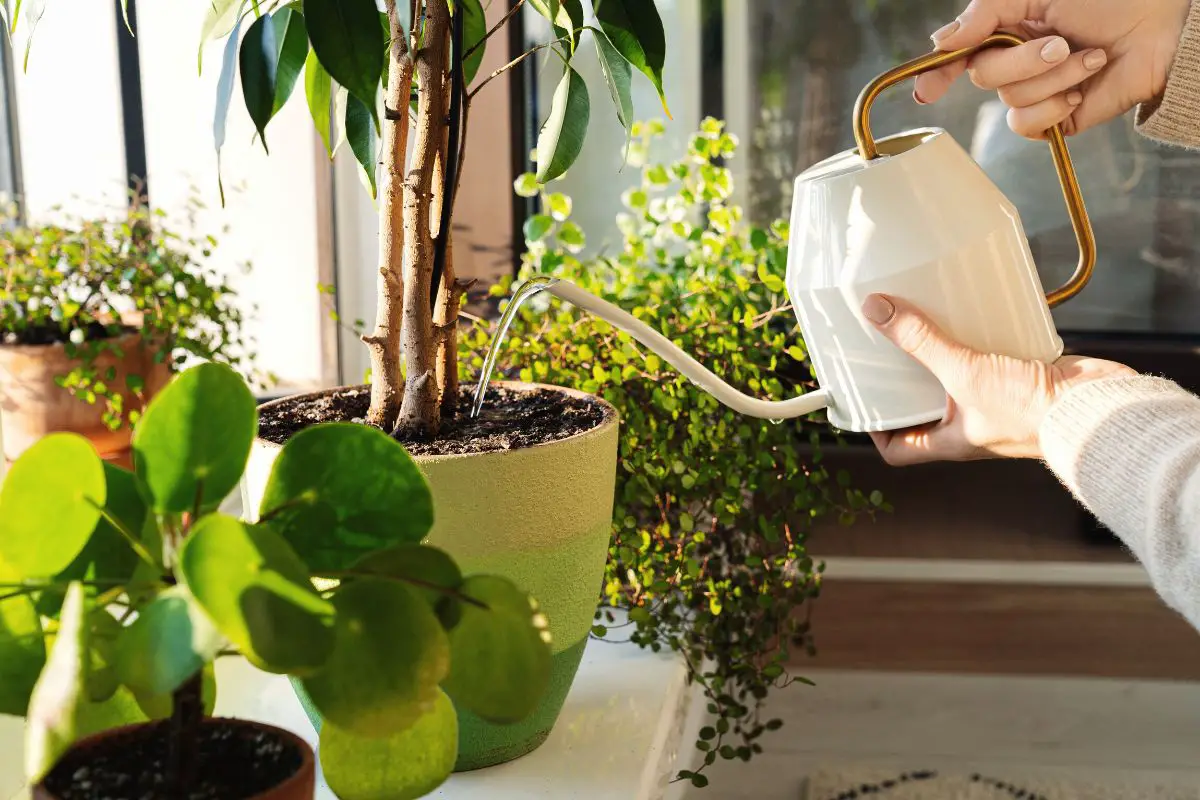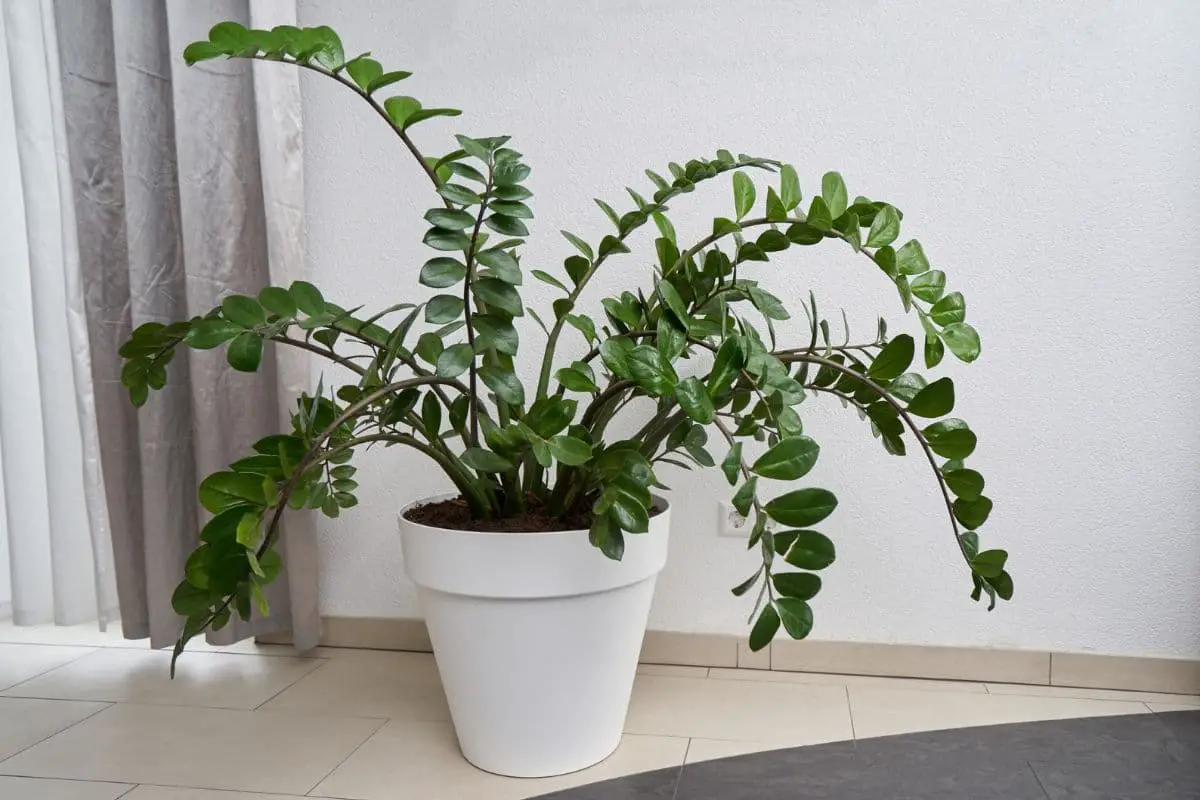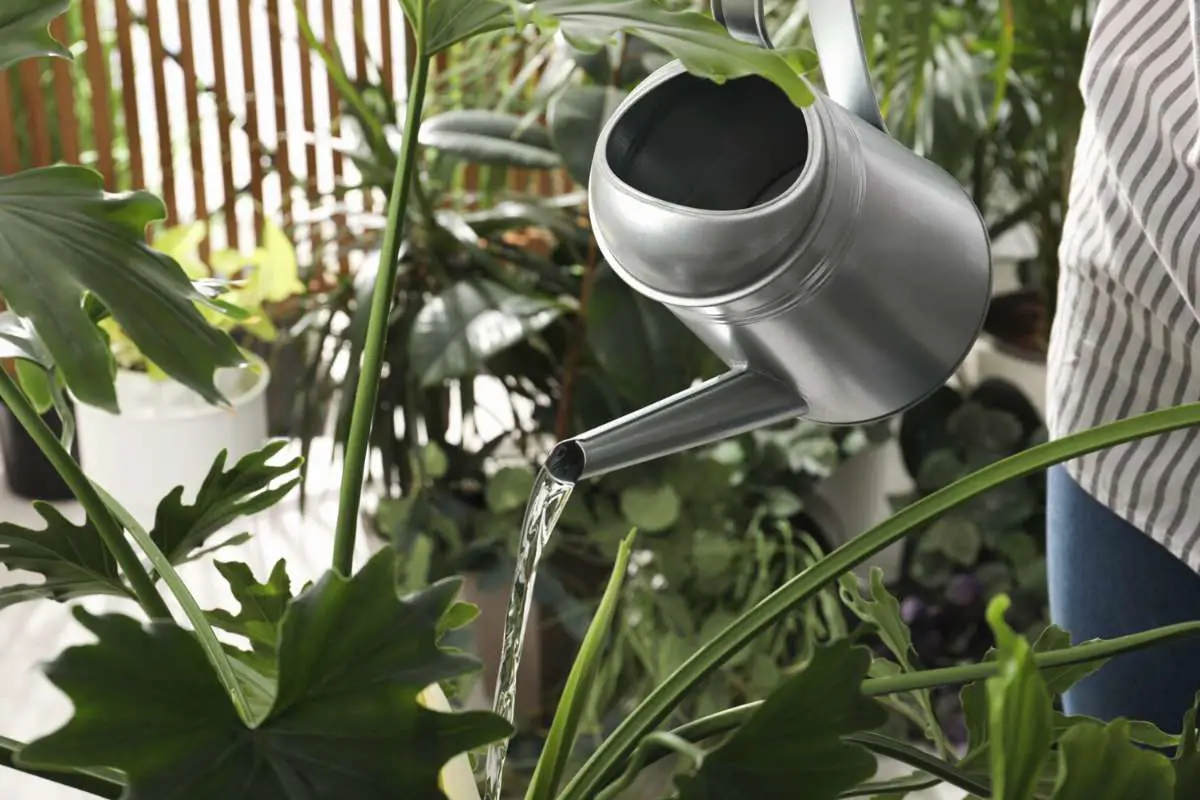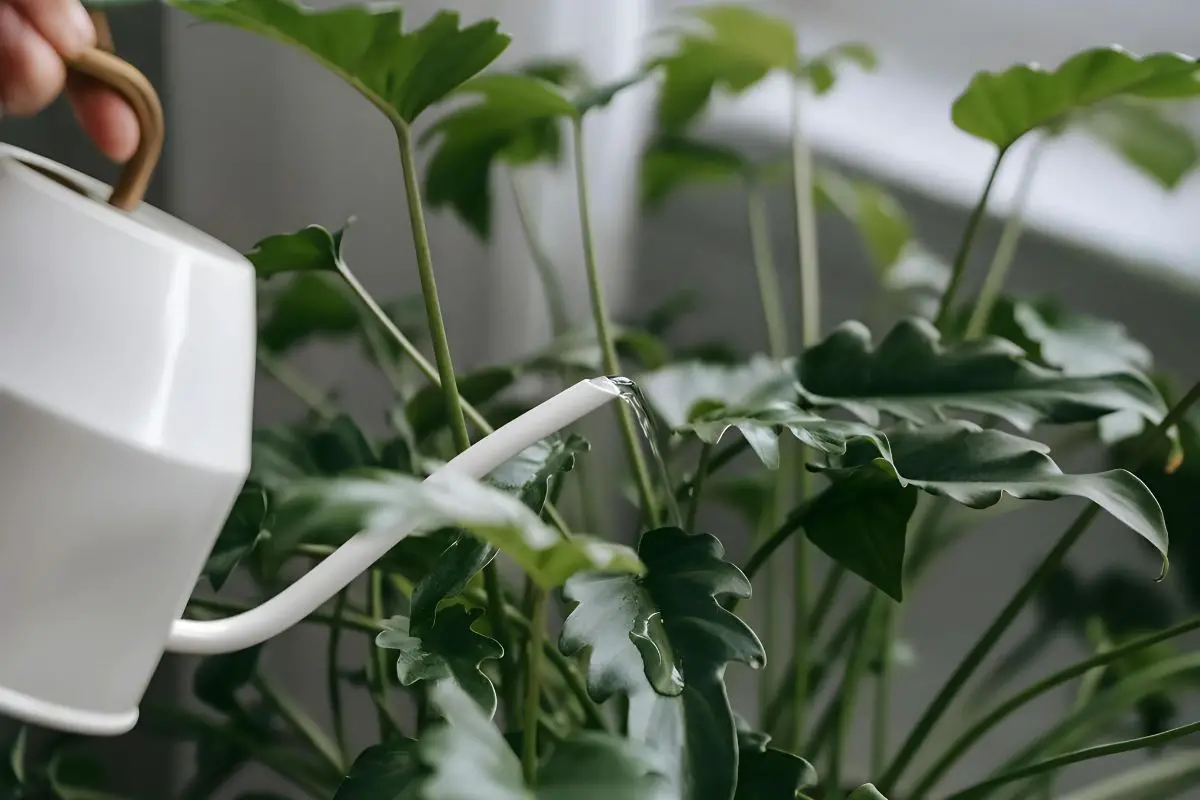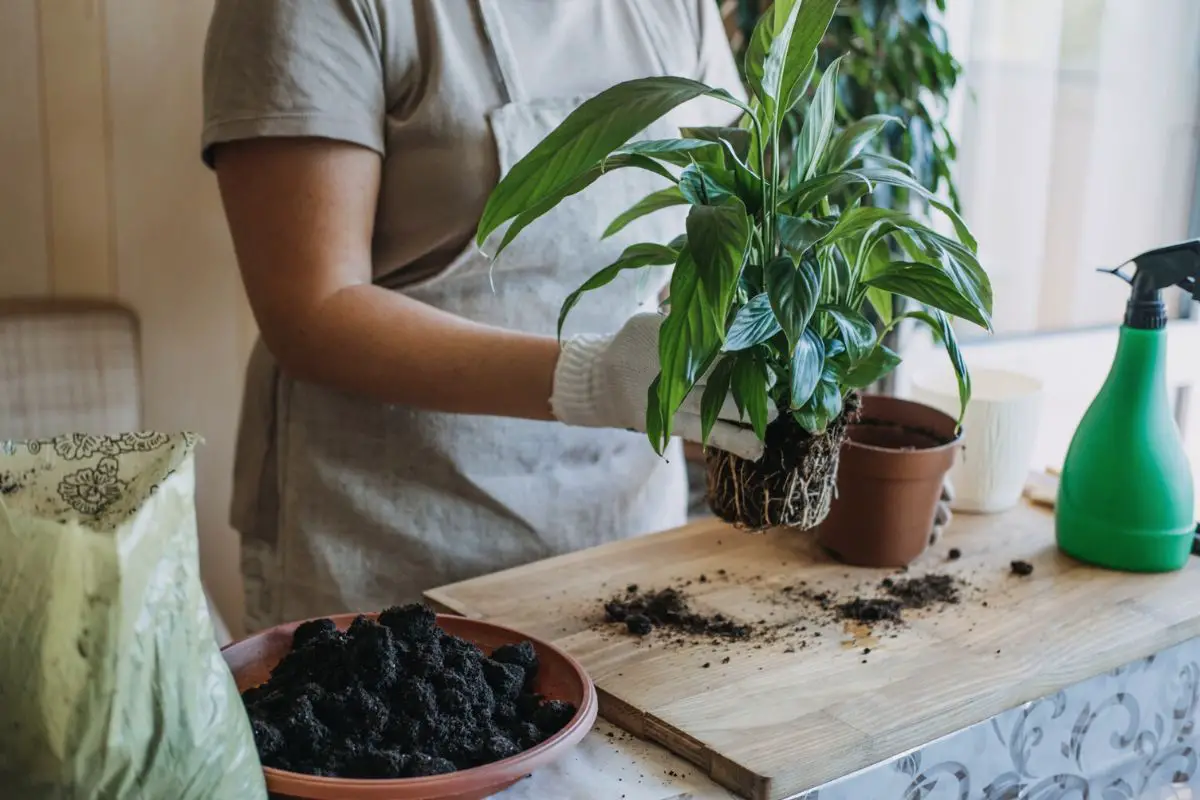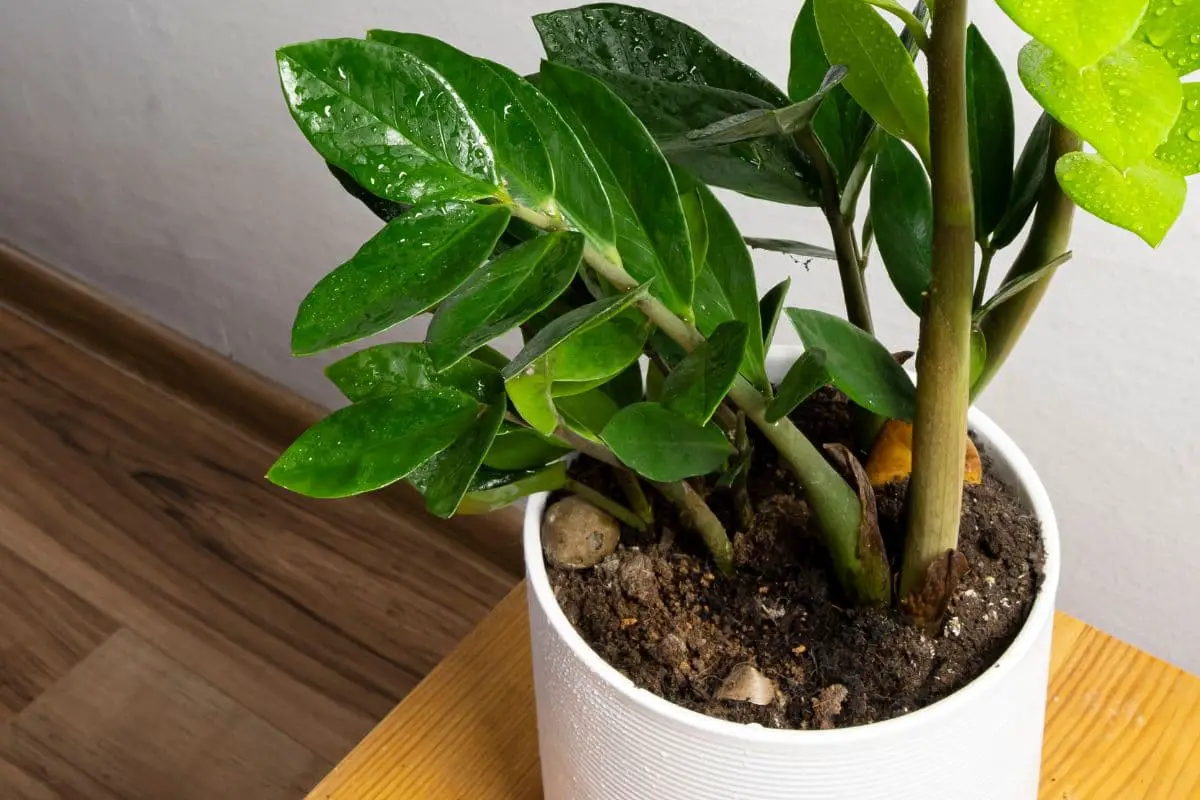ZZ plants are popular houseplants primarily due to their easy care requirements and beautiful foliage. They are slow growers with more active development in the spring and summer months. Observing a ZZ plant not growing can be alarming, especially when it doesn’t put out new shoots despite the warm season.
A stunted ZZ plant could be due to poor environmental conditions, such as inadequate light, temperature, water, pot size, and soil nutrients. Plant age and pest infestations can also cause your plant to grow more slowly.
It’s important to understand what abnormal slow or stunted growth is in ZZ plants and how to identify the underlying causes to apply a proper solution. This article will explore the issues and their symptoms in more detail and provide tips on how to fix them.

ZZ Plant Natural Growth Patterns: An Overview
ZZ plants come from the tropical regions of Eastern and Southern Africa where the seasons are divided into wet (rainy) and dry (scarce rains).
In the wet season, ZZ plants enter brief periods of growth spurts.
- Young plants or shoots gain an additional 6 inches (15 cm) or so in height within 3-6 months (spring until summer). They typically reach the mature height of 2-4 feet (0.6-1.2 m) within 5 years.
- Mature plants put more energy into lateral growth by producing new rhizomes or bulbs. Each rhizome can grow 1-2 shoots during the growing season if the conditions are right. The older stems may slowly fade and new shoots will grow from the older rhizomes.
When rainy days become scarce again, ZZ plants will grow slowly to preserve their energy and remaining moisture. Due to this climate pattern, they have adapted to grow more actively when there’s abundant water supply.
Dormancy
Even during the dry season, ZZ plants retain their green foliage because they store moisture in their fleshy rhizomes or bulbs and succulent stems. Their leaves also have a waxy coating, delaying moisture loss.
These tropical evergreens grow in frost-free regions, so they don’t enter full dormancy.
If you can maintain indoor lighting, watering, and temperatures within optimal and constant levels, your plant will keep growing all year round without growth spurts.
However, ZZ plants cultivated indoors in cooler climates may exhibit distinct behaviors.
If indoor temperatures are kept around 60-65 °F (15.6-18 °C) in winter, accompanied by drier conditions, it can trigger your plant to reduce metabolic activities. The growth rate may fall to only 1-2 inches (2.5-5 cm) during the cold season.
As temperatures rise in spring, the soil may dry out more quickly. Higher temperatures and more frequent watering will then encourage your plant to enter more active growth.

Symptoms of Stunted Growth
Slower growth is natural among ZZ plants outside of the growing season. However, if growth doesn’t pick up to the aforementioned rates within the growing season in spring, the plant might be stunted.
Stunted growth is a condition where a plant is too stressed to produce healthy foliage, flowers, or fruits. The plant’s size and growth rate also drop significantly.
In ZZ plants, this condition can manifest in any of the following ways:
Deformed Leaves
Healthy ZZ plant leaves are green, glossy, and elliptical. The younger leaves are typically paler than the older ones. A stunted plant may grow new leaves, but they’ll be wrinkled, curled, or lack the characteristic elliptical shape.
Unremarkable Growth
ZZ plants enter a growth spurt in spring when the light intensity rises and you increase the watering frequency. Within the next 6 months, your plant should gain a noticeable increase in size and new shoots may emerge from underground rhizomes.
In case of stress, the increase in height or number of new shoots is less than expected.
Yellowing Leaves
ZZ plant leaves can range from pale green to dark green. Some new cultivars like the ‘Raven’ have deep purple leaves.
Yellowing ZZ leafs can indicate care issues, such as poor watering or lighting, that may be responsible for the slow or stunted growth.
Dropping Leaves
Dropping leaves is another sign that your plant is stressed due to overwatering or underwatering. A stressed plant will not have enough energy to put out new growth while trying to overcome its underlying health issues.
Soft or Rotting Stems
Too much water can cause ZZ plant stems to rot and become mushy. This usually indicates an even more severe problem below the soil because the roots and rhizomes will rot before the stems.
As the stems rot, no moisture or nutrients will be sent upward, causing stunted growth and plant death eventually.
Common Causes
The abovementioned symptoms will guide you in diagnosing and addressing the cause of slow growth.
Inadequate Light
ZZ plants thrive in dappled sunlight in their native environment because they grow in areas where they’re shaded by tree canopies. Indoors, they can tolerate low-light conditions like a spot next to a northern window.
They need light energy to produce food for the whole plant. This energy also goes to the base of the plant to produce new rhizomes.
When they don’t get enough light energy, your plant will show the following symptoms:
- Stems leaning toward the source, such as a window or a light bulb
- Leaves turning yellow or growing sparse
- Lack of new growth
To fix this issue, you must provide your plant with natural sunlight or use high-quality grow lights. Here are some tips:
- Position the plant 4-8 feet (1.2-2.4 m) from a bright eastern window because this will give your plant gentle morning sun.
- Hang sheer curtains in the summer or if you have a southern or western window.
- Rotate your plant by 90-180° every time you water it to promote even or bushy growth.
- If you have a limited natural light source, keep them under artificial lights. To boost growth, use a full-spectrum grow light 6-12 inches (15-30 cm) above your plant and keep it on for 10-12 hours daily. This exceeds the natural sunlight needs of a ZZ plant, as the artificial lights cannot fully compensate for the intensity of sun rays.
Temperature Stress
As tropical natives, ZZ plants prefer moderate temperatures between 65 and 85 °F (18 and 29 °C). Outside this range, you may notice the following issues:
- Extended exposure to over 90 °F (32 °C) can lead to heat stress. Your plant will be more prone to dehydration leading to yellowing leaves, wilting, and stunted growth.
- Temperatures below 60 °F (15.6 °C) will make the leaves appear paler.
- ZZ plants stop growing at 50 °F (10 °C) or lower.
To protect your ZZ plants, it’s best to:
- Keep them indoors where temperatures remain at stable levels all year round. Low light, moisture, and temperature levels naturally trigger ZZ plants to go into self-preservation mode and have significantly slower growth.
- Avoid placing them near AC vents and drafty windows or doors to prevent unwanted temperature fluctuations that can cause plant stress.
Overwatering
ZZ plants don’t like constantly wet soil. Overwatering can lead to the following symptoms:
- Wet soil surface 3 days or so after watering
- Yellow leaves
- Leaf drops
- Mushy stems
- Mushy bulbs
- Rotten or smelly roots
Watering your plant too often can lead to root rot. The bulbs will also rot from the excess moisture. Once they do, they won’t be able to send moisture and nutrients toward the shoots, leading to slowed or stunted growth. The rot will spread upward and kill the plant if left unattended.
You can fix overwatering issues based on the severity:
- Minor overwatering problems: Reduce the watering frequency and wait until the upper half of the potting mix is dry before rehydrating your plant.
- In case of root or bulb rot: Repot your ZZ plant if less than half of the roots are rotten.
- The bulbs and more than half of the roots are damaged: Propagate the remaining healthy leaves instead.

Underwatering
Although drought-tolerant, ZZ plants can suffer from stress when left unwatered for extended periods. Water is necessary to deliver nutrients to different plant plants and promote growth. Without enough water, it’s only natural for your plant to grow more slowly or not at all.
ZZ plants can tolerate dry conditions, but constantly underwatering will cause your plant to have:
- Crusty, cracked soil
- Yellow leaves
- Brown leaves with dry, crisp tips
- Leaf drops
- Wrinkled bulbs
- Stunted growth
Severe underwatering can dry out the soil and make it hydrophobic, especially since ZZ plant soil typically contains large portions of sand. When this happens, the soil pulls away from the sides of the pot or forms cracks. The water will then run through the gaps without rehydrating your plant’s roots.
Here are some ways to fix underwatering:
- Minor underwatering issue: Increase watering frequency on hot, dry days, especially when you keep your plant in brighter conditions. Check the soil around ten days after watering and water deeply as soon as the top half of the potting soil is dry.
- Severe underwatering with hydrophobic soil: You can bottom water the plant for 10-30 minutes or dunk it in a tub of water with a wetting agent. Alternatively, you can repot your plant in fresh soil mix.
Improper Potting
ZZ plants need infrequent repotting because it can take 2-3 years before their roots can fill out their pots. However, if transplanted into a small container, they can outgrow it more quickly and become rootbound, eventually leading to stunted growth.
The plant won’t be able to absorb enough moisture, and the soil will most likely be depleted of nutrients, so the plant can’t grow.
You can confirm this is the problem when you see the following signs:
- Roots poking out of the drainage holes and the soil surface
- Exposed bulbs
- Water leaking out of the drainage holes soon after pouring it in
You can fix the problem by repotting your plant in a container that’s about 2 inches (5 cm) wider and deeper than the old one.
If the plant has several bulbs, you can divide and transplant them into pots that are 1-2 inches (2.5-5 cm) wider and 2-3 inches (5-7.6 cm) deeper than the rootball.
Pro tip: ZZ plants like a well-draining soil mix with equal parts compost and coarse sand/perlite.
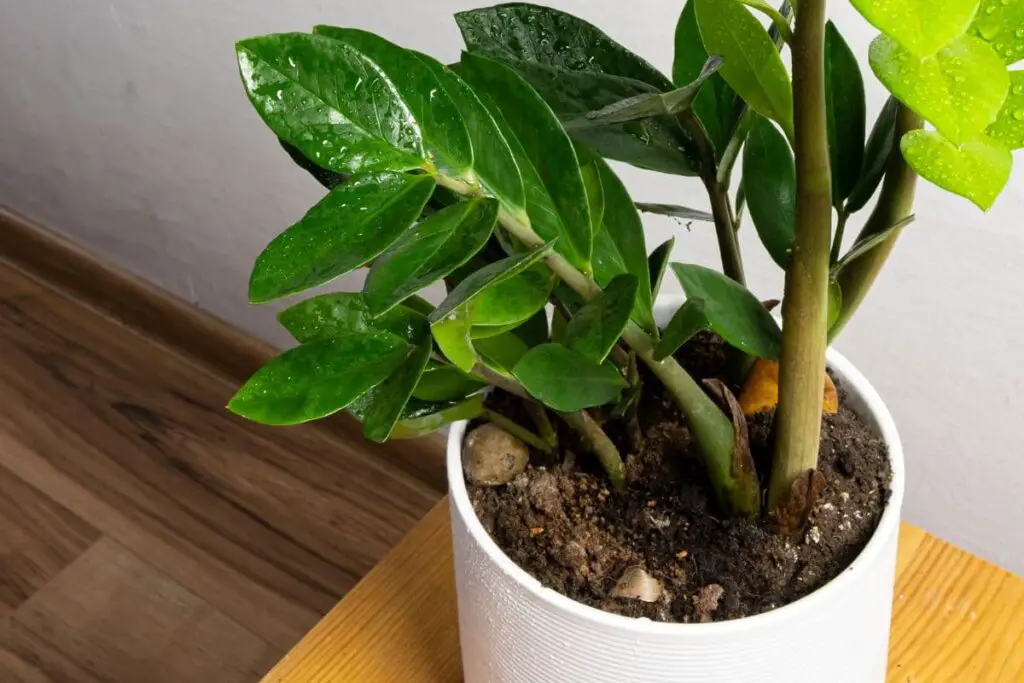
Nutrient Deficiency
ZZ plants don’t feed heavily on fertilizers. When planted in rich soil mix, they can even get by without supplementary fertilization until the next repotting session (2-3 years). However, in soilless mixes with little organic matter, they may show nutrient deficiency through yellowing leaves.
You can tell this symptom apart from other causes because the older or bottom leaves usually turn yellow first. This is due to nitrogen deficiency. You can fix this by feeding your plant a slow-release 10-10-10 fertilizer in spring.
You can also prevent this issue in the future by:
- Using high-quality compost in the initial potting mix
- Feeding your plant the balanced fertilizer only once in spring in the second year
- Repotting in fresh soil mix in the third year
Pest Infestation
Here are some pests that may attack ZZ plants:
- Aphids
- Mealybugs
- Scale mites
- Snails and slugs
- Caterpillars
Aphids, mealybugs, and scale mites hide beneath leaves or along stems and suck the sap out.
Snails, slugs, and caterpillars feed on the leaves, causing irregular holes. However, they’re only likely to attack ZZ plants left outdoors.
Pests can attack ZZ plants, but they likely won’t slow down the growth of a mature plant. On the other hand, a severe infestation can indirectly affect a young plant’s growth rate.
Pest infestations are usually secondary to stress caused by watering issues. A stressed plant has little resistance to pest attacks and will succumb more quickly to the damage, especially if it’s young and has a weak root system.
Defoliation from pest attacks can be detrimental to young plants with only a few leaves. Leaf loss and the low-light condition ZZ plants are usually exposed to will limit the amount of energy the plant can absorb. This will lead to slower or stunted growth.
You can treat your plant by following these steps:
- Eliminate pests by picking them off manually using tweezers or cotton swabs and dropping them in soapy water.
- Spray your plant generously with neem oil solution in the evening once a week for up to 6 weeks.
- Continue with the neem oil spray once every 2 weeks for the next 2 months to prevent reoccurrence.
- Isolate new plants for at least 8 weeks to prevent pest infestation in your indoor garden.
Age
Each ZZ plant bulb can live and continue producing new shoots for 5-10 years. After this, the quality and number of new shoots will decline due to cell aging or senescence.
ZZ plants may continue to survive from the newer and younger bulbs. That’s why it’s important to divide and repot your plant regularly. This will help rejuvenate your plant and promote new growth.
You can also propagate your ZZ plant from leaf cuttings so you can enjoy them for several more decades.
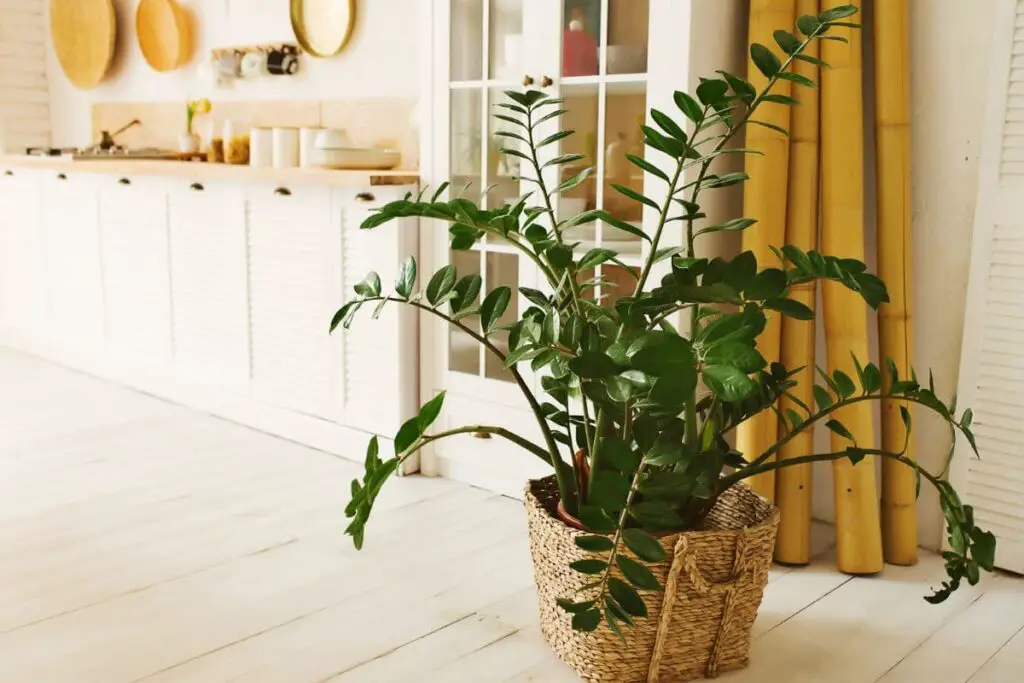
Preventative Measures and Best Practices
Most of the causes above are preventable (except aging).
To ensure optimal growth for your ZZ plant, remember the following tips:
Regular Monitoring
ZZ plants have low maintenance needs, so you don’t have to check on them as frequently as you would for other houseplants.
A good rule of thumb is to create a rough watering schedule. Check on your plant 10-14 days after a watering session.
You can use this timing to:
- Check the soil moisture to avoid watering problems.
- Inspect the leaves and stems for signs of pests.
- Check the plant for signs of stress (i.e., leaf drop, legginess, discoloration).
Routine checks can help you diagnose and treat issues promptly before they get out of control and lead to irreversible damage.
Seasonal Care Adjustments
The lower light and temperature levels in winter in the U.S. can lead to slower moisture loss from the soil of your ZZ plant.
Therefore, it’s important to make the following adjustments:
- Adjust watering frequency in winter. During the cold season, the soil may take 4-6 weeks to dry out enough. Make it a habit to check the soil to confirm when the top half is dry before watering your plant.
- Avoid fertilizing outside the growing season. When the plant becomes less active during the cold season, the excess fertilizer salts in the potting soil can suck the moisture out of the roots or bulbs. Add this to the low watering frequency and your plant will be at higher risk of dehydration.
Selecting the Right Pot and Soil
By using the right pot and soil mix, you can prevent a lot of problems in ZZ plants, such as watering issues and nutrient deficiency.
Pot Size and Material
ZZ plants don’t like oversized pots, which can contain excess soil and moisture and increase the risk of root rot. I’ve found that a container that’s 2 inches (5 cm) wider and deeper than the rootball is the perfect size for ZZ plants.
I also like using unglazed terracotta pots because of the following qualities:
- Their earthy color is an excellent contrast to the plant’s vibrant green leaves.
- They’re breathable and can efficiently wick away excess moisture.
- They can support the weight of the top-heavy ZZ plant for the next 2-3 years.
Make sure the pot has drainage holes at the bottom to prevent waterlogging, which can lead to root rot.
Soil Mix
I’ve tried different types of potting mixes for ZZ plants and found that the compost-perlite mix works best. When I ran out of perlite, coarse sand worked just as well. This mix is well-draining and rich in organic matter with a gentle dose of nutrients.
Just make sure to use high-quality finished compost to provide your plant with enough nourishment to promote new growth soon after repotting.
Repotting Tips
The best time to repot ZZ plants is in spring.
Avoid repotting in summer when temperatures can go above 85 °F (29 °C) because there’s a higher risk of heat stress, and your plant is approaching a resting period. Your plant might not have enough time to establish in its new pot before the cold season arrives.
The same goes for fall and winter because your plant will likely struggle to recover from transplant shock because of slower metabolic activity.
In case of root rot, you don’t have a choice but to repot your plant right away, regardless of the season. Otherwise, your plant will die. Just note that the recovery will be much slower than when treated during the active growing season.
When you’re ready to repot, follow these steps:
- Prepare the appropriate pot and soil mix (based on the tips above). Moisten the fresh soil mix.
- Water your plant 1-2 days before repotting.
- Loosen the soil around the edges of the pot using a flat knife or spatula. Be careful not to damage the roots or wound the bulbs.
- Carefully slide the plant out of the pot and remove the soil using your fingers.
- Divide the bulbs of overgrown plants by gently disentangling the roots.
- Prune the damage or rotten roots with sterile scissors. Wear gloves when cutting leaves or stems because the sap may cause skin irritation.
- Place the plant in the new pot and soil and bury the roots and bulbs under 1 inch (2.5 cm) of moist soil mix.
- Place the pot in bright, indirect light.
- Wait until the top half of the potting mix is dry before watering deeply. If the old soil was hydrophobic and the plant is dehydrated, water the soil deeply.
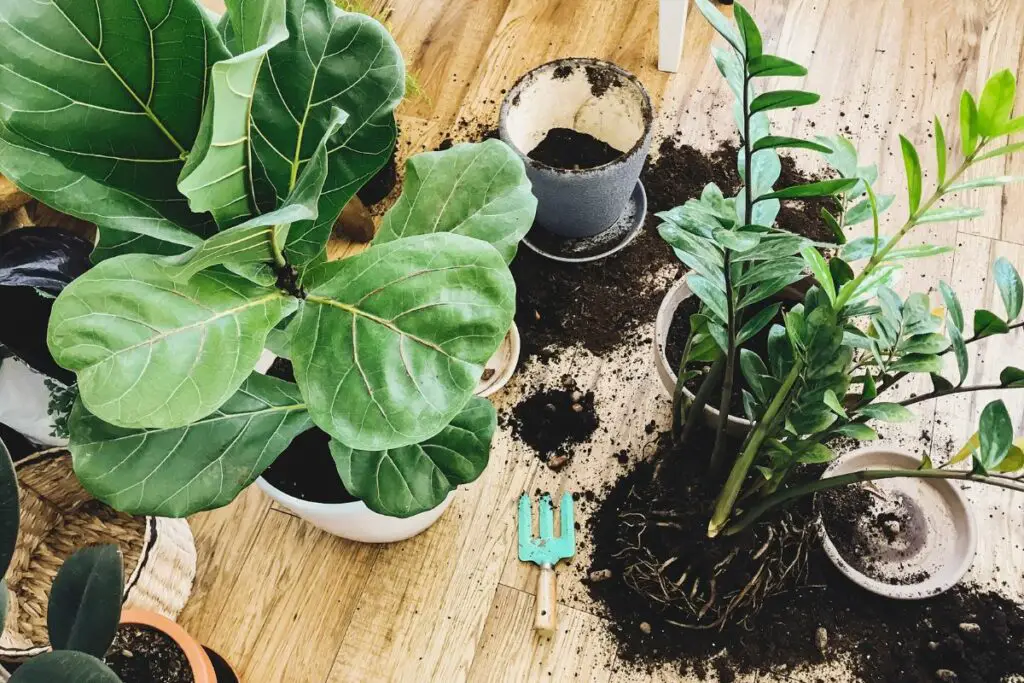
Final Thoughts
ZZ plants are excellent for indoor gardens because they look like small trees that remain compact for a long time. However, their slow growth can be troublesome, especially if you propagate them from cuttings or purchase very small plants.
You can encourage your plant to maximize its growth potential by providing it with adequate care. You need to be patient and consistent with your care practices because this plant naturally grows slowly.
Check your plant regularly and look out for signs of stress that may cause an even slower growth. Early diagnosis will help you address and fix the issue before it gets worse.
If you’ve had a very slow-growing ZZ plant, I’d love to hear about your experience and tips on how you encouraged new growth in your plant!

